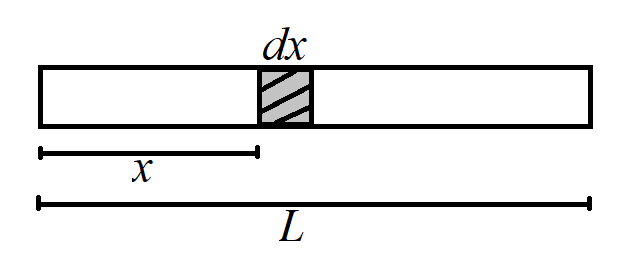
Answer
474.9k+ views
Hint: When the centre of mass of a body cannot be found using the axis of symmetry, it can be found by integration. Thickness or length of body can be divided into tiny strips, each with thickness $dx$. Integrate mass of each element multiplied by its respective position with respect to $x$ and divide by the integration of mass of each element. We will get the required position of centre of mass.
Formula used:
${{X}_{CM}}=\dfrac{\int\limits_{0}^{L}{xdm}}{\int\limits_{0}^{L}{dm}}$
Complete step by step answer:
The centre of mass of a distribution of mass in space is the unique point, an imaginary point in the body of matter, where the weighted relative position of all the distributed masses sums up to be zero. This is the point through which a force may be applied to cause some linear acceleration without an angular acceleration. For simple rigid bodies with uniform density, the centre of mass is located at the centroid. The centre of mass of any system is a point which represents the mean position of the matter in a body or system.
The centre of mass of a system can be calculated by taking the value of all the masses we are trying to find the centre of mass between and multiplying them by their positions. Then, we add these two and divide them by the sum of all the individual masses.
${{X}_{CM}}=\dfrac{{{m}_{1}}{{x}_{1}}+{{m}_{2}}{{x}_{2}}+.....{{m}_{n}}{{x}_{n}}}{{{m}_{1}}+{{m}_{1}}+.....{{m}_{n}}}$
In case of a non-uniform rod, the position of centre of mass depends upon the density distribution of the rod.

The centre of mass of a non-uniform rod is given by,
${{X}_{CM}}=\dfrac{\int\limits_{0}^{L}{xdm}}{\int\limits_{0}^{L}{dm}}$
Where,
$L$ is the length of the rod
$x$ is the position of mass element from one end of rod
${{X}_{CM}}=\dfrac{\int\limits_{0}^{L}{x\rho dx}}{\int\limits_{0}^{L}{\rho dx}}$
Where, $\rho =\dfrac{dm}{dx}$
We are given,
$\dfrac{dm}{dx}=\dfrac{k{{x}^{2}}}{L}$
Therefore, $dm=\dfrac{k{{x}^{2}}}{L}dx$
${{X}_{CM}}=\dfrac{\int\limits_{0}^{L}{x\dfrac{k{{x}^{2}}}{L}dx}}{\int\limits_{0}^{L}{\dfrac{k{{x}^{2}}}{L}dx}}$
\[{{X}_{CM}}=\dfrac{\dfrac{K}{L}\left[ \dfrac{{{x}^{4}}}{4} \right]_{0}^{L}}{\dfrac{K}{L}\left[ \dfrac{{{x}^{3}}}{3} \right]_{0}^{L}}=\dfrac{\dfrac{{{L}^{4}}}{4}-0}{\dfrac{{{L}^{3}}}{3}-0}\]
${{X}_{CM}}=\dfrac{3L}{4}$
The centre of mass of a given rod is situated at a distance of $\dfrac{3L}{4}$from one end of the rod.
Hence, the correct option is A.
Note: If the rod has constant density $\rho $, given in terms of mass per unit length, then the mass of rod is just the product of the density and length of rod. In the above case we were given the density of rod in the form of mass per unit length, therefore, while integrating unit mass of rod, we took mass as the product of density of rod and the position of the unit mass from one end of the rod.
Formula used:
${{X}_{CM}}=\dfrac{\int\limits_{0}^{L}{xdm}}{\int\limits_{0}^{L}{dm}}$
Complete step by step answer:
The centre of mass of a distribution of mass in space is the unique point, an imaginary point in the body of matter, where the weighted relative position of all the distributed masses sums up to be zero. This is the point through which a force may be applied to cause some linear acceleration without an angular acceleration. For simple rigid bodies with uniform density, the centre of mass is located at the centroid. The centre of mass of any system is a point which represents the mean position of the matter in a body or system.
The centre of mass of a system can be calculated by taking the value of all the masses we are trying to find the centre of mass between and multiplying them by their positions. Then, we add these two and divide them by the sum of all the individual masses.
${{X}_{CM}}=\dfrac{{{m}_{1}}{{x}_{1}}+{{m}_{2}}{{x}_{2}}+.....{{m}_{n}}{{x}_{n}}}{{{m}_{1}}+{{m}_{1}}+.....{{m}_{n}}}$
In case of a non-uniform rod, the position of centre of mass depends upon the density distribution of the rod.

The centre of mass of a non-uniform rod is given by,
${{X}_{CM}}=\dfrac{\int\limits_{0}^{L}{xdm}}{\int\limits_{0}^{L}{dm}}$
Where,
$L$ is the length of the rod
$x$ is the position of mass element from one end of rod
${{X}_{CM}}=\dfrac{\int\limits_{0}^{L}{x\rho dx}}{\int\limits_{0}^{L}{\rho dx}}$
Where, $\rho =\dfrac{dm}{dx}$
We are given,
$\dfrac{dm}{dx}=\dfrac{k{{x}^{2}}}{L}$
Therefore, $dm=\dfrac{k{{x}^{2}}}{L}dx$
${{X}_{CM}}=\dfrac{\int\limits_{0}^{L}{x\dfrac{k{{x}^{2}}}{L}dx}}{\int\limits_{0}^{L}{\dfrac{k{{x}^{2}}}{L}dx}}$
\[{{X}_{CM}}=\dfrac{\dfrac{K}{L}\left[ \dfrac{{{x}^{4}}}{4} \right]_{0}^{L}}{\dfrac{K}{L}\left[ \dfrac{{{x}^{3}}}{3} \right]_{0}^{L}}=\dfrac{\dfrac{{{L}^{4}}}{4}-0}{\dfrac{{{L}^{3}}}{3}-0}\]
${{X}_{CM}}=\dfrac{3L}{4}$
The centre of mass of a given rod is situated at a distance of $\dfrac{3L}{4}$from one end of the rod.
Hence, the correct option is A.
Note: If the rod has constant density $\rho $, given in terms of mass per unit length, then the mass of rod is just the product of the density and length of rod. In the above case we were given the density of rod in the form of mass per unit length, therefore, while integrating unit mass of rod, we took mass as the product of density of rod and the position of the unit mass from one end of the rod.
Recently Updated Pages
Fill in the blanks with suitable prepositions Break class 10 english CBSE

Fill in the blanks with suitable articles Tribune is class 10 english CBSE

Rearrange the following words and phrases to form a class 10 english CBSE

Select the opposite of the given word Permit aGive class 10 english CBSE

Fill in the blank with the most appropriate option class 10 english CBSE

Some places have oneline notices Which option is a class 10 english CBSE

Trending doubts
Fill the blanks with the suitable prepositions 1 The class 9 english CBSE

How do you graph the function fx 4x class 9 maths CBSE

When was Karauli Praja Mandal established 11934 21936 class 10 social science CBSE

Which are the Top 10 Largest Countries of the World?

What is the definite integral of zero a constant b class 12 maths CBSE

Why is steel more elastic than rubber class 11 physics CBSE

Distinguish between the following Ferrous and nonferrous class 9 social science CBSE

The Equation xxx + 2 is Satisfied when x is Equal to Class 10 Maths

Differentiate between homogeneous and heterogeneous class 12 chemistry CBSE




